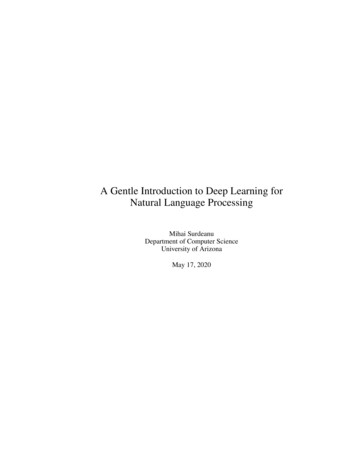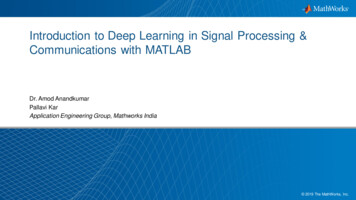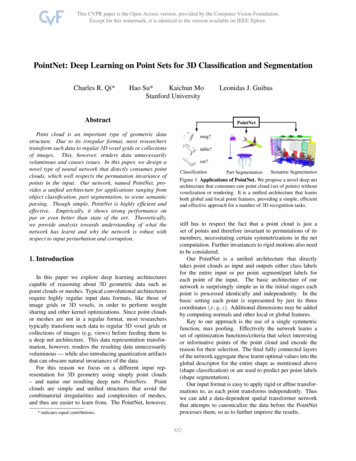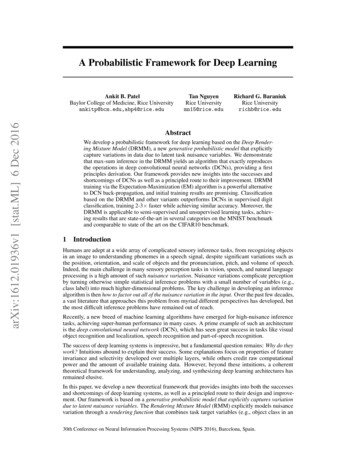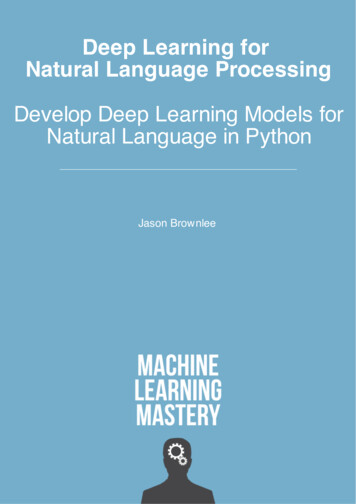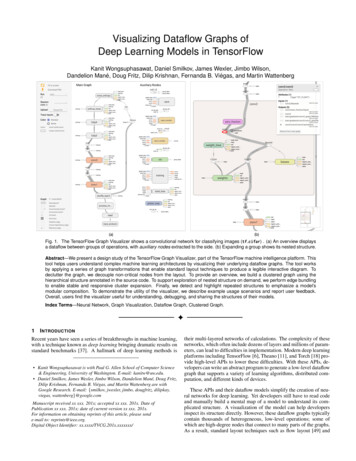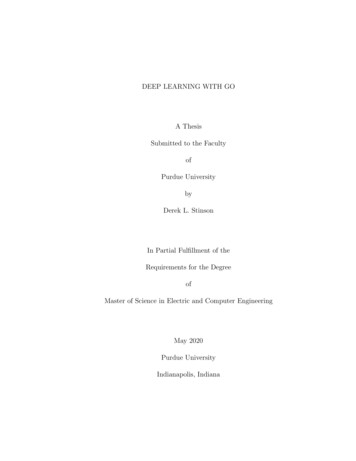
Transcription
DEEP LEARNING WITH GOA ThesisSubmitted to the FacultyofPurdue UniversitybyDerek L. StinsonIn Partial Fulfillment of theRequirements for the DegreeofMaster of Science in Electric and Computer EngineeringMay 2020Purdue UniversityIndianapolis, Indiana
iiTHE PURDUE UNIVERSITY GRADUATE SCHOOLSTATEMENT OF THESIS APPROVALDr. Zina Ben MiledDepartment of Electrical and Computer EngineeringDr. Brian KingDepartment of Electrical and Computer EngineeringDr. Maher RizkallaDepartment of Electrical and Computer EngineeringApproved by:Dr. Brian KingHead of Graduate Program
iiiACKNOWLEDGMENTSI would like to thank my thesis advisor, Dr. Zina Ben Miled, for her support andguidance throughout this thesis. I would like to thank Dr. Brian King for advisingme throughout the M.S.E.C.E program at IUPUI. I would like to thank Dr. MaherRizkalla for being a part of my thesis committee. I would like Sherrie Tucker formaking sure I am aware of the things that need to complete before the deadlines.I would like to thank Dr. Steven Rovnyak for giving me the opportunity to teachthe ECE 20700 lab. I would like to thank my Mother and Father. Without them, Iwould not have been able to pursue graduate school. I would like to thank my sonfor contributing more at home and allowing me to be able to focus on completingmy thesis work. I would also like to thank my daughter with her ability to make memindful of things around me.
ivTABLE OF CONTENTSPageLIST OF TABLES . . . . . . . . . . . . . . . . . . . . . . . . . . . . . . . . . . viiLIST OF FIGURES . . . . . . . . . . . . . . . . . . . . . . . . . . . . . . . . . viiiSYMBOLS . . . . . . . . . . . . . . . . . . . . . . . . . . . . . . . . . . . . . . ixABBREVIATIONS . . . . . . . . . . . . . . . . . . . . . . . . . . . . . . . . . .xABSTRACT . . . . . . . . . . . . . . . . . . . . . . . . . . . . . . . . . . . . . xi1 INTRODUCTION . . . . . . . . . . . . . . . . . . . . . . . . . . . . . . . .12 RELATED WORK . . . . . . . . . . . . . . . . . . . . . . . . . . . . . . . .32.1Go and Cuda . . . . . . . . . . . . . . . . . . . . . . . . . . . . . . . .32.2Deep Learning Frameworks . . . . . . . . . . . . . . . . . . . . . . . . .33 METHODOLOGY . . . . . . . . . . . . . . . . . . . . . . . . . . . . . . . .53.13.2Neural Networks . . . . . . . . . . . . . . . . . . . . . . . . . . . . . .53.1.1Forward Propagation . . . . . . . . . . . . . . . . . . . . . . . .63.1.2Backward Propagation . . . . . . . . . . . . . . . . . . . . . . .7Convolution Layer . . . . . . . . . . . . . . . . . . . . . . . . . . . . .83.2.1Forward Propagation . . . . . . . . . . . . . . . . . . . . . . . . 113.2.2Back Propagation . . . . . . . . . . . . . . . . . . . . . . . . . . 153.3Activation Layer . . . . . . . . . . . . . . . . . . . . . . . . . . . . . . 183.4Weight Optimization . . . . . . . . . . . . . . . . . . . . . . . . . . . . 183.53.4.1Gradient Descent . . . . . . . . . . . . . . . . . . . . . . . . . . 183.4.2Momentum Update . . . . . . . . . . . . . . . . . . . . . . . . . 193.4.3Adagrad . . . . . . . . . . . . . . . . . . . . . . . . . . . . . . . 193.4.4Adam . . . . . . . . . . . . . . . . . . . . . . . . . . . . . . . . 19Implementation . . . . . . . . . . . . . . . . . . . . . . . . . . . . . . . 204 RESULTS . . . . . . . . . . . . . . . . . . . . . . . . . . . . . . . . . . . . . 22
vPage4.1Code Samples . . . . . . . . . . . . . . . . . . . . . . . . . . . . . . . . 255 CONCLUSION . . . . . . . . . . . . . . . . . . . . . . . . . . . . . . . . . . 275.1Challenges . . . . . . . . . . . . . . . . . . . . . . . . . . . . . . . . . . 275.2Future Work . . . . . . . . . . . . . . . . . . . . . . . . . . . . . . . . . 285.3GoCuNets . . . . . . . . . . . . . . . . . . . . . . . . . . . . . . . . . . 28REFERENCES . . . . . . . . . . . . . . . . . . . . . . . . . . . . . . . . . . . . 29APPENDICESA ConvNetGo . . . . . . . . . . . . . . . . . . . . . . . . . . . . . . . . . . . . 32A.1 Tensor . . . . . . . . . . . . . . . . . . . . . . . . . . . . . . . . . . . . 32A.2 Convolution . . . . . . . . . . . . . . . . . . . . . . . . . . . . . . . . . 32A.2.1 Convolution Struct . . . . . . . . . . . . . . . . . . . . . . . . . 32A.2.2 Convolution Forward Algorithm . . . . . . . . . . . . . . . . . . 33A.2.3 Convolution Forward Window . . . . . . . . . . . . . . . . . . . 34A.3 Leaky . . . . . . . . . . . . . . . . . . . . . . . . . . . . . . . . . . . . 35A.3.1 Leaky Struct . . . . . . . . . . . . . . . . . . . . . . . . . . . . 35A.3.2 Leaky Forward . . . . . . . . . . . . . . . . . . . . . . . . . . . 35A.3.3 Fully Connected . . . . . . . . . . . . . . . . . . . . . . . . . . . 36B GoCuNets . . . . . . . . . . . . . . . . . . . . . . . . . . . . . . . . . . . . . 37B.1 Tensor . . . . . . . . . . . . . . . . . . . . . . . . . . . . . . . . . . . . 37B.2 Builder . . . . . . . . . . . . . . . . . . . . . . . . . . . . . . . . . . . . 38B.2.1 Builder Data Structure . . . . . . . . . . . . . . . . . . . . . . . 38B.2.2 Builder Method Convolution Layer . . . . . . . . . . . . . . . . 39B.2.3 Builder Method Convolution Weights . . . . . . . . . . . . . . . 40B.2.4 Builder Method Activation Layer . . . . . . . . . . . . . . . . . 41B.3 Module Interface . . . . . . . . . . . . . . . . . . . . . . . . . . . . . . 42B.3.1 VanillaModule . . . . . . . . . . . . . . . . . . . . . . . . . . . . 43B.3.2 ModuleNetwork . . . . . . . . . . . . . . . . . . . . . . . . . . . 44C GoCudnn . . . . . . . . . . . . . . . . . . . . . . . . . . . . . . . . . . . . . 45
viPageC.1 Linking Cuda to Go. . . . . . . . . . . . . . . . . . . . . . . . . . . . 45C.2 NewModuleData . . . . . . . . . . . . . . . . . . . . . . . . . . . . . . 45C.3 Cuda Concat Kernel . . . . . . . . . . . . . . . . . . . . . . . . . . . . 46C.4 MakeKernel . . . . . . . . . . . . . . . . . . . . . . . . . . . . . . . . . 47C.5 (k *Kernel) Launch() . . . . . . . . . . . . . . . . . . . . . . . . . . . . 48C.6 Concat Kernel Launch . . . . . . . . . . . . . . . . . . . . . . . . . . . 49C.7 MallocManagedGlobalEx . . . . . . . . . . . . . . . . . . . . . . . . . . 50C.8 Copy Memory . . . . . . . . . . . . . . . . . . . . . . . . . . . . . . . . 51C.9 Interface io.Reader . . . . . . . . . . . . . . . . . . . . . . . . . . . . . 52C.10 Interface io.Writer. . . . . . . . . . . . . . . . . . . . . . . . . . . . . 53
viiLIST OF TABLESTablePage4.1Samples taken from the MNIST database with the corresponding one-hotencoding of their labels. . . . . . . . . . . . . . . . . . . . . . . . . . . . . 234.2Execution time (in seconds) per epoch for each batch size for the ConvNetGo (CPU implementation) and GoCuNets (GPU implementation). . . 244.3Number of epochs, training time for each batch size when executing theGoCuNets (GPU) model. Convergence was decided when the average lossfor the testing data was less than 0.01. . . . . . . . . . . . . . . . . . . . . 26
viiiLIST OF FIGURESFigure3.1PageFully connected network with one input layer, one hidden layer and oneoutput layer. . . . . . . . . . . . . . . . . . . . . . . . . . . . . . . . . . .63.2Schematic representation of 4D tensors. Each column is a tensor. . . . . . 103.3A visualization of padding stride and dilation with an input of (4,4) andweights of (3,3). . . . . . . . . . . . . . . . . . . . . . . . . . . . . . . . . . 114.1The layers of the CNN used to test the proposed framework. . . . . . . . . 224.2Execution time per epoch for CoCuNets (GPU implementation) and ConvNetGo (CPU implementation) with increasing batch size. . . . . . . . . . 25
ixSYMBOLSWWeights or filter for a layerYOutput tensor on a forward pass.XInput tensor on a forward pass. WGradients for weighs or filter. YInput tensor for gradients on a backward pass. XOutput tensor for gradients on a backward pass.NBatch dimension or number of neurons.CTensor channel dimension.HTensor height dimension.WTensor width dimension
xABBREVIATIONSCNNConvolutional neural networkFCNNFully connected neural networkANNArtificial neural networkNHWCTensor format (N-Total Batch, H-Input Height, W-Input Width,C-Total Channels)NCHWTensor format (N-Total Batch,C-Total Channels, H-Input Height,W-Input Width)dimsDimensionsdimDimension
xiABSTRACTStinson, Derek L. M.S.E.C.E., Purdue University, May 2020. Deep Learning withGo. Major Professor: Zina Ben Miled.Current research in deep learning is primarily focused on using Python as a support language. Go, an emerging language, that has many benefits including nativesupport for concurrency has seen a rise in adoption over the past few years. However, this language is not widely used to develop learning models due to the lack ofsupporting libraries and frameworks for model development. In this thesis, the use ofGo for the development of neural network models in general and convolution neuralnetworks is explored. The proposed study is based on a Go-CUDA implementationof neural network models called GoCuNets. This implementation is then comparedto a Go-CPU deep learning implementation that takes advantage of Go’s built inconcurrency called ConvNetGo. A comparison of these two implementations shows asignificant performance gain when using GoCuNets compared to ConvNetGo.
11. INTRODUCTIONIn late 2007 at Google, Robert Griesemer, Rob Pike and Ken Thompson began working on a new computer language. They were frustrated with the excessive complexityand lack of safe and efficient multiprocessor features in the languages they used todevelop server software. When looking at all the available languages, they concludedthat in picking a language you had to choose at most two out of three options. Theseare efficient compilation, efficient execution, or ease of programming [1].Their solution was the creation of Go. Go attempts to address these issues bybeing a statically typed, compiled language. Go has built in concurrency, a garbagecollector, rigid dependency specification (no codependent packages) [1], and toolsused to compile, link, test, format, import and document Go code [2].There are several frameworks used in deep learning. These include TensorFlow [3],PyTorch [4], Keras [5], MXNet [6] and Chainer [7]. TensorFlow contains APIs forPython, c, Java, and Go. MXNet also has multiple APIs that are in Python, C ,Clojure, Java, Julia, Perl, R, and Scala. PyTorch API uses Python, but it has bindingsin C . Keras and Chainer only use Python. Out of the above mentioned deeplearning frameworks, only TensorFlow has a Go API. However, this API is mostlyused for running models in a Go application that were developed with Python.There is growing support for the use of Go in data science and computer visionwith packages like Gonum [8] and GoCV [9]. However, there is still a demand for deeplearning tools in Go. In response to this demand, ConvNetGo [10], GoCudnn [11] [12],HipGo [13] [14], MIOpenGo [15] [16], and GoCuNets [17] were developed.GPU computation is used heavily in deep learning in order to accelerate executiontime. There are 3rd party open source packages for Nvidia’s CUDA such as cuda5 [18],gorgonia/cu [19], and cuda [20]. These packages have their strengths and weaknesses.GoCudnn was developed to overcome those weaknesses. GoCudnn started out as
2bindings for cuDNN [11]. It includes bindings for some of the other libraries thatare found in the CUDA [21] API. These libraries include nvJPEG, CUDA Runtime,CUDA Driver, NPP, and NVRTC. There are also kernels that were developed outsideof cuDNN that are helpful for computer vision and deep learning.This thesis proposes a Go-Cuda implementation to support the development ofneural network models including convolutional neural networks called GoCuNets. Tocompare the performance of GoCuNets, a CPU implementation of neural networkmodels called ConvNetGo was also developed. Chapter 2 includes a review of previous related work and in particular previous Go-Cuda implementations. Chapter 3discusses the methodology used in the design of the convolutional neural networks under both GoCuNets and ConvNetGo. The performance of these implementations arecompared in Chapter 4. Chapter 5 provides a summary of the benefits and limitationsof the proposed GoCuNets frameworks and offers direction of future work.
32. RELATED WORKGo is a new language. Go 1.0 was released in March 2012 [22]. The focus of this thesisis to integrate GPU computation with the Go language for the purpose of developingdeep learning models. This chapter includes a review of some of the packages thatwere developed for GPU computation with Go, the applications that use them, andother deep learning frameworks.2.1Go and CudaCuda5 [18] is the first binding package for CUDA. It is a highly flexible packagethat has one huge limitation. It handles errors by panicking. Gorgonia/cu [19] takesCuda5 and gets rid of this issue by having the function return an error interface andby adding cuBLAS, NVRTC, and some of cuDNN.Another binding that is available on Github is unixpickle/cuda [20]. It is a lightweight package with a few functions that interface with the cuda driver. It containssub-packages for cuBLAS and cuRAND. The best feature of this package is the useof Go’s garbage collector to handle memory management in the GPU.2.2Deep Learning FrameworksTensorFlow [3] is probably the most known deep learning framework. TensorFlowwas originally developed by the Google Brain team. It is now an open source platform.TensorFlow has stable Python and C APIs. There are APIs in other languages,including Go, but they are not supported with the same level of maturity.Caffe [23] is another widely known deep learning framework. It was developedat Berkeley by Yangqing Jia. It is an open source project. Caffe’s official API is in
4C . In 2017, Caffe2 was announced by Facebook [24]. In 2018 it was integratedwith another Facebook project called PyTorch [4]. Pytorch has APIs in Python andC .ConvNetjs [25] is an open source deep learning framework that uses javascript andis ran in an internet browser. It was developed by Andrej Karpathy. It has visualdemos of a few types of neural networks. The demo includes images of the tensorsthat are used in different layers of the network.Gorgonia [26] is an open source deep learning API that uses Go. It uses theGorgonia/cu Go bindings for CUDA. The goal of Gorgonia is to provide a machinelearning/graph computation based library. Using Gorgonia should feel familiar toother Python learning APIs like TensorFlow or Keras. However, as a deep learningAPI on Go, Gorgonia might not be the right fit for developers that have never usedPython.
53. METHODOLOGYNeural networks consist of layers of neurons. These networks include an input layer,one or more hidden layers, and an output layer. The neurons accept a set of inputswhich are multiplied by weights and processed through an activation function. Theoutput of the neuron in one layer propagates to the input of a neuron in a subsequentlayer until reaching the output layer.This architecture is at the foundation of most current networks. The key todeveloping a successful network is: Determining the value of the weights of the links between neurons, a processwhich is referred to as training, and Defining a suitable architecture for the network including the number of layers,the number of neurons in each layer, and the activation used at the output ofeach neuron.In this chapter, the implementation or the proposed neural network is describedstarting from a simple neural network to the target convolutional neural network.3.1Neural NetworksFigure 3.1(a) shows a fully connected neural network [27] with one single hiddenlayer. In this figure, the input and output of the network are represented by rectangular boxes. The neurons are represented by circles and the weights are depicted bythe links between the neurons. Bias nodes are a constant input of one. The neuronswill have a bias weight that is summed with the other links. These are indicated byshaded circles in Figure 3.1(a).
6(a) Neural network architecture.(b) Matrix representation of the network.Fig. 3.1. Fully connected network with one input layer, one hidden layerand one output layer.A fully connected layer can be viewed as a matrix multiplication between a 1xNinput matrix and an NxM weights matrix. The result is a 1xM matrix. The bias 1xMmatrix is then added to the previous result. This process is shown in Figure 3.1(b).The main two operations associated with the network are forward propagation andbackward propagation. These two operations are used during training to update theweights. Once the weights of the network are determined, the forward propagation isused on a new input to generate the estimated output.3.1.1Forward PropagationIn the forward propagation process, the output of each layer is generated by usingEquation (3.1)(t)(t)(t)(t)Y(1,M ) X(1,N ) W(N,M ) B(1,M )(3.1)
7Where, X(1,N ) is the input vector with N elements, W(N,M ) is the weight matrix,and B(1,M ) is the bias vector for the layer. The bias values in Equation (3.1) areadded to the weighted term X(1xN ) W(N xM ) resulting in an output vector with Melements, Y(1,M ) .Equation (3.1) is implemented in Algorithm 1.Algorithm 1 Forward Propagation in a Fully Connected LayerInput:X, W, BOutput: Y1:MatrixMatrixfunction ForwadPropagationFullyConnected(X, Y, W, B)for n 0 to len(Y) do2:for m 0 to len(X) do3:sum sum W [n][m] X[m]4:Y [n] sum B[n]5:3.1.2Backward PropagationBackward Propagation [28] is used to train the network. It consists of threefunctions: The first function takes the output error it receives from the next layer and usesit to calculate the errors associated with the input it received from the previouslayer (Equation 3.2a), The second function accumulates the errors for the weights of each neuron(Equation 3.2b), and The third function evaluates the error for the bias vector (Equation 3.2c).
8(t)(t) X(1xN ) Y(1xM ) (W (t) )T(M xN )(t)(t) W(N xM ) (X (t) )T(N x1) Y(1xM )(t)(t) B(1xN ) Y(1xN )(3.2a)(3.2b)(3.2c)(t)(t)Where, X(1xN ) is the vector that holds the error due to the output Y(1xM )(t)propagated back from the previous layer. W(N xM ) represents the error matrix forthe weights of the current layer. It will be used to adjust the current layer’s weights(t)during training. B(1xM ) is the error vector for the bias vector. It is used to adjust(t)(t)the bias vector during training. X(1xM ) is the input and W(N xM ) is the weight matrixof the current layer from the previous iteration of the algorithm. Equation (3.2) isimplemented in Algorithm 2.Algorithm 2 Fully Connected Back PropagationInput:dY, X, WOutput: dX, dW, dB1:MatrixMatrixfunction FCBackProp(dY, dW, dB, X, W, dX)2:SetToZero(dX)3:for n 0 to len(dY) do4:for m 0 to len(dX) do5:dX[m] dX[m] W [n][m] dY [n]6:dW [m][n] X[m] dY [n]7:3.2dB[n] dY [n]Convolution LayerThe convolution layer [29] is very similar to the fully connected layer. However,instead of each neuron having a weight for each input, and only one output. Each neuron will have a volume of weights that step through the input in multiple dimensionswith each step returning an output value.
9A typical architecture for a convolution layer receives a 4D input volume called atensor with a format of NHWC or NCHW [30]. NHWC represents a tensor’s orderingby batch, height, width, and channel, respectively. For example, a NHWC tensor ofbytes with the dimensions [20,320,240,4] is used to process a batch of 20 images witha height of 320 and width of 240. The 32 bit color information is represented as 4byte color vector. Under NCHW, the dimensions would look like [20,4,320,240] withthe pixels separated out into 4 feature maps, with a height of 320 and a width of 240.Performance can vary depending on the tensor format. For example, Intel recommends NCHW for their newer processors [31], and Nvidia recommends NHWC inorder to take advantage of the tensor core in their new architectures [32]. In thisthesis NCHW is adopted, because it is easier to visualize.The input, weights, and output should be in the same format. A convolutionlayer will contain a 4D tensor of weights. Under the adopted NCHW tensor format,N represents a batch of ”neurons” as opposed to a batch of inputs. The values storedin each CHW are the feature weights of N . These feature weights are also calledkernels. The number of kernels is C, with a height of H and a width of W . Foreach neuron in W.N , there will be the same number of kernels (W.C) as there arefeature maps from the input (X.C). The output tensor batch size is the same asthe input’s batch size (i.e., N ). The result of a neuron’s convolution of the inputwill be an output feature map with size HW . The number of neurons in the weightswill determine the number of output feature maps. The size of the output channeldimension (Y.C) is determined by the number of neurons in the weights (W.N ). Thesizes of HW are determined by the properties of the convolution between the inputand weights. An illustration of the 4D tensors in a convolutional neural network isshown in Figure 3.2.There are a few convolutional processing steps that are used in accessing the databeing held by the input tensor. These are performed in the H and W dimensionsand consist of padding, stride, and dilation. The properties of these data processing
10Fig. 3.2. Schematic representation of 4D tensors. Each column is a tensor.steps will affect the size of the output tensor. A visualization of the convolutionalprocessing steps can be seen in Figure (3.3).Padding (p) adds zeros around the H and W dimensions of the input tensor x.The size of the padding should be less than the size of the weights. If the padding isgreater than or equal to the weights (w) then the output edges will be zeros.Stride (s) corresponds to the step of the window over the input tensor in the Hand W dimensions. Larger strides will reduce the size of the output.Dilation (d) spreads the weights apart in the H and W dimensions giving themextended coverage without additional parameters.As implied by the above three transformations, the shape of the output tensor isdependent on the parameters used to process the data. Equation (3.3) shows the size
11of the output tensor based on the padding, stride, dilation. Not all parameter valuescan be used since some choices of p, w, s, d may lead to a non-integer size y for theoutput tensor. Therefore, best practice starts by fixing the size y of the output tensorand then deriving the size x of the input tensor using Equation (3.4).Fig. 3.3. A visualization of padding stride and dilation with an input of(4,4) and weights of (3,3).y x 2p ((w 1) d 1) 1s(3.3)x (y 1) s 2p ((w 1) d 1)3.2.1(3.4)Forward PropagationThe values of the output tensor are calculated using Equation (3.5).(t)Yn,k,yh,yw Bk W.C 1X W.H 1X W.WX 1c 0i 0j 0(t)(t)Wk,c,i,j Xn,c,xh,xw(3.5)
12Where X represents the input tensor. W are the filter weights with k, c, i, jrepresenting the output channel size, input channel size, height position, and widthposition, respectively. Bk is a bias array. The size of the bias array is the same asthe size of the output channel k.Padding is realized with Equation (3.6), where the values n, c, xh, and xw, arethe batch size, channel size, height position, and width position, respectively. Theheight and width positions are calculated by using xh and xw as shown in Equation(3.7). In turn, xh and xw are calculated with respect to the output tensor positionyh, yw, slide (s), weight positions i, j, dilation (d), and padding offset (p). Xn,c,xh,xw if 0 xh X.H and 0 xw X.WXn,c,xh,xw 0otherwisexh yh s i d p,xw yw s j d p(3.6)(3.7)The forward propagation function is executed into two steps. The first step is thesliding weight window over the input. This function returns the summation of theindividual window as depicted in Algorithm 3. The second step stores the output ofthe previous layer as shown in Algorithm 4.
13Algorithm 3 Convolution Forward Window - Equation(3.5).Input:X, WTensorxinput offsetn,kbatch and neuron indexddilation sizeReturns: sum1:summation of W*X windowfunction ConvForwardWin(X,W,x,n,k,d)2:sum 03:for c 0 to W.C do4:for i 0 to W.H do5:xh x.h i d.h6:if xh 0 and xh X.W then7:. add dilation height offset for Xfor j 0 to W.W do8:xw x.w j d.w9:if xw 0 and xw X.H then10:return sum. add dilation width offset for Xsum sum W [k][c][i][j] X[n][c][xh][xw]
14Algorithm 4 Convolution Forward PropagationInput:X, W, BTensorp, s, dPadding, stride and dilation sizesOutput: Y1:2:3:Tensorfunction ConvForward( )for n 0 to Y.N dofor k 0 to Y.C do4:x.h p.h5:for yh 0 to Y.H do6:x.w p.w7:x.h x.h yh s.h8:for yw 0 to Y.W do9:. set -padding height offset for Xx.w x.w yw s.w. set -padding width offset for X. add stride height offset for X. add stride width offset for X10:sum ConvF orwardW in(X, W, n, x, k, d)11:Y [n][k][yh][yw] B[k] sum
153.2.2Back PropagationAs in the case of a regular neural network, errors in a CNN are passed backwardfrom the next layer. Each output error value is accumulated into two different tensors.The first is for the input tensor which is scaled according to the weights of each outputas shown below.(t) Xn,c,xh,xw W.C 1X W.H 1X W.WX 1c 0i 0(t)(t)Wk,c,i,j Yn,k,yh,yw(3.8)j 0Where, X (t) is the tensor that holds the errors for X (t) , W (t) is the weight tensorfor the layer, and Y (t) is the errors received for Y (t) . Equation (3.8) is implementedin Algorithm 5.Algorithm 5 Convolution Backward Data Window - Equation (3.8)Input:WWeight tensordygradientxinput offset valuen,kbatch and neuron indexddilation sizeOutput: dX1:2:3:Input error tensorfunction ConvInputGrad(dX, W, dy, x, n, k, d)for c 0 to W.C dofor i 0 to W.H do4:xh x.h i d.h5:if xh 0 and xh X.W then6:for j 0 to W.W do7:xw x.w j d.w8:if xw 0 and xw X.H then9:dX[n][c][xh][xw] dX[n][c][xh][xw] W [k][c][i][j] dy
16The second tensor is an accumulation of errors used to update the weights. Itis obtained by multiplying the input values by the corresponding output errors asshown below:(t) Wk,c,i,j W.C 1X W.H 1X W.WX 1c 0i 0(t)(t)Xn,c,xh,xw Yn,k,yh,yw(3.9)j 0Where W (t) is the tensor that holds the errors for the weights, X (t) is the inputtensor for the layer, and Y (t) represents the corresponding errors from the output.Equation (3.9) is implemented in Algorithm 6.Algorithm 6 Convolution Backward Weight Window - Equation (3.9)Input:XInput tensordygradientxinput offset valuen,kbatch and neuron indexddilation sizeOutput: dW1:2:3:Weight update tensorfunction ConvWeightGrad(dW, X, dy, x, n, k, d)for c 0 to W.C dofor i 0 to W.H do4:xh x.h i d.h5:if xh 0 and xh X.W then6:for j 0 to W.W do7:xw x.w j d.w8:if xw 0 and xw X.H then9:dW [k][c][i][j] dW [k][c][i][j] X[n][c][xh][xw] dy
17The error for the bias neurons is the summation of the output errors for thatneuron as shown below.(t) Bk Y.N 1 Y.H 1XX Y.WX 1n 0yh 0(t) Yn,k,yh,yw(3.10)yw 0Where B (t) is the tensor that holds the errors for the Bias, and Y (t) is theoutput error.Algorithm 7 Convolution Back PropagationInput:X, W, dYinput, weight and output error tensorsp, s, dpadding, stride and dilation sizesOutput: dX, dW, dB1:input, weight and bias update tensorsfunction ConvBackward(X, dX, W, dW, dB, dY, p, s, d)2:ZeroAll(dX)3:for n 0 to Y.N do4:for k 0 to Y.C do5:x.h p.h6:for yh 0 to Y.H do7:x.w p.w8:x.h x.h yh s.h9:for yw 0 to Y.W do10:x.w x.w yw s.w11:dy dY [n][k][yh][yw]12:ConvInputGrad(dX, W, dy, n, x, k, d). Algorithm 513:ConvW eightGrad(dW, X, dy, n, x, k, d). Algorithm 614:dB[k] dB[k] dy
183.3Activation LayerThe activation layer introduces non-linearity to a neural network. This operationis performed element-wise. During forward propagation, the activation function isapplied to the output of the previous layer. Some of the common activation functionsinclude logistic ( 1 e1 x ), rectified linear unit (Relu, if x 0 f (x) 0, otherwise,f (x) x), and the leaky rectified linear unit (leaky, if x 0 f (x) 0.01, otherwise,f (x) x).3.4Weight OptimizationThe weights in the network are updated at every training iteration. Several,approaches can be used to perform this update. Moreover, some of these approachesare guided by hyper-parameters that are either defined before training or adjustedduring training. The choice of the hyper-parameters may dictate the ability of thenetwork to converge. A summary of the main weight optimization approaches isprovided next.3.4.1Gradient DescentThe simplest way to minimize the loss function at the output of the network is toupdate the weight in the direction of the gradient descent [33] as shown below.W (t) W (t 1) W (t)(3.11)Where, W (t) is the updated weight value at iteration t, W (t 1) is the weight value atiteration t 1, and W (t) is the weight error tensor. The hyper-parameter, , is calledthe learning rate and indicates the rate at which the updates are being performed.
193.4.2Momentum UpdateCompared to gradient descent, momentum update [28] takes into considerationthe weight adjustment in the previous iterations as shown below:M (t) α M (t 1) W (t)(3.12)W (t) W (t 1) M (t)(3.13)Where, M (t) is the momentum at iteration t, M (t 1) is the momentum at theprevious iteration, α is the momentum rate, is the learning rate, W (t) is the updatedweight, W (t 1) is the weight at the previous iteration, and W (t) is the weight errortensor. The hyper-parameters for this approach are and α.3.4.3AdagradAdagrad [34] stores the sum of the squares of the gradient for each individualparameter as shown in Equation (3.14). This value is then used to scale the gradientas shown in Equation (3.15). The hyper-parameter β in the Adagrad approach isused
May 07, 2020 · Clojure, Java, Julia, Perl, R, and Scala. PyTorch API uses Python, but it has bindings in C . Keras and Chainer only use Python. Out of the above mentioned deep learning frameworks, only TensorFlow has a Go API. However, this API is mostly used for running mo


